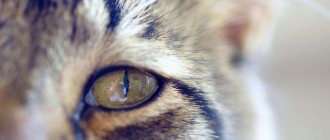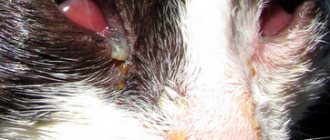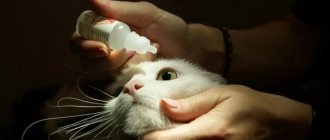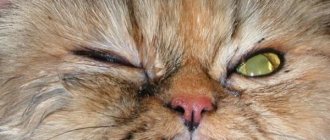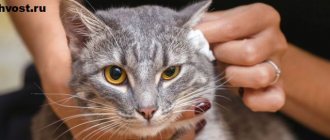Cats a couple of centuries ago were considered the most picky animals with good health. However, home breeding made the pets too weak. The eyes are extremely sensitive organs to various diseases. They are often exposed to various injuries and diseases. So, let’s look at why a cat’s eyes fester and she becomes lethargic, because most cat lovers are interested in this question.
And this is correct, since premature determination of the causes of the disease and elimination of the consequences will lead to a full recovery of the cat.
What does purulent discharge from a cat's eyes look like?
The purulent discharge from the eyes of a cat is opaque in appearance, has a viscous consistency, and has a yellowish or greenish color, which determines the appearance of the microflora that caused the formation of pus. Depending on the amount of discharge, it can be in the corners of the cat’s eyes, form streaks on his face and dry yellowish crusts, and also form cloudy filmy deposits on the conjunctiva.
The appearance of the eye changes, the most common are:
- redness of the conjunctiva and eyelids;
- swelling of the conjunctiva and eyelids;
- prolapse of the third eyelid on the affected eye;
- blepharospasm - narrowing of the palpebral fissure caused by protective contraction of the eye muscles;
- photophobia - the cat squints the affected eye when in the light, trying to find dark places.
The animal's behavior changes:
- the cat scratches its eyes with its paws and rubs its muzzle against surrounding objects;
- blinks frequently;
- sneezes rarely if this is due to part of the discharge entering the nasal cavity through the nasolacrimal duct, and often if purulent discharge from the eyes is associated with the development of an infectious disease;
- tries to hide in dark places;
- the cat is apathetic, does not want to play, and his appetite decreases.
Purulent discharge is opaque, viscous consistency, with a yellowish or greenish tint
What treatment does the doctor prescribe?
After carrying out the necessary tests, the veterinarian prescribes medications that will cure exactly the disease that caused the suppuration. For example, without eliminating the cause of the allergic reaction, it is useless to wash the cat’s eyes and drip them; pus will still appear. And if suppuration is caused by toxoplasmosis or chlamydia, antibiotic therapy is necessary.
For local treatment, the following drugs are most often prescribed: “Bars”, “Iris”, “Mizofen”, “Neoconjunctivet” or “Anandin”. You can also rinse your eyes from pus with special solutions purchased at a veterinary pharmacy. It is best to use Lakrimin or Medkinos.
What diseases can cause your eyes to fester?
Purulent discharge from the eyes is a symptom of both eye diseases and general diseases.
Common diseases accompanied by purulent discharge from the eyes
Common diseases that cause cat eyes to fester:
- Allergy - at the beginning of the disease, the discharge is mucous in nature, bilateral in nature, which changes to purulent with the addition of secondary microbial flora. Additionally observed: sneezing;
- nasal discharge;
- redness of the conjunctiva;
- skin rash.
- instability of appetite;
- panleukopenia: sudden fever up to 40–41 ° C;
- fever;
- fever;
- periodic fever;
- at the very beginning of the disease, the purulent discharge is unilateral, later the second eye is affected;
Chemosis is the predominant symptom when the conjunctiva is affected by chlamydia
- fever;
- sneezing, coughing;
Photo gallery: systemic diseases in which purulent discharge from the eyes is observed
Panleukopenia causes profuse purulent discharge from the eyes and nose.
With herpetic conjunctivitis, the discharge from the eyes is purulent in nature
With chlamydia, purulent discharge from the eyes is typical, as well as chemosis - swelling of the conjunctiva
Measures to improve the condition of the conjunctiva
In case of general diseases, purulent discharge from the eyes is treated only together with the underlying pathology of which they are a symptom. To improve the condition of the eyes in case of general diseases, the following are used as part of complex therapy:
- Regular toilet of the eyes to remove pus and microbial accumulations using hygienic eye lotions: Klini;
- Veda;
- Dewdrop.
- Tsiprovet;
- tetracycline ophthalmic;
- Forvet;
Anandin is a drug that has anti-inflammatory, antiviral and immunomodulatory effects.
Table: eye diseases with purulent discharge
| Type of disease | Symptoms | Treatment |
| Eye injury |
|
|
| Conjunctivitis is an inflammation of the conjunctiva and eyelids, which is unilateral or bilateral. |
|
|
| Keratitis - inflammation of the cornea |
|
|
| Blepharitis - inflammation of the eyelids |
|
|
| Uveitis - inflammation of the choroid of the eye |
|
|
| Entropion is a chronic injury to the surface of the eye by the edge of the deformed eyelid, as well as by its eyelashes. |
| Surgical restoration of the correct position of the eyelid |
| Dacryocystitis - inflammation of the lacrimal sac |
|
|
Thus, purulent discharge from a cat’s eyes may indicate both the presence of a systemic disease and the development of eye disease. Moreover, purulent inflammation can mask the primary nature of the process and return after the use of antibiotics without treating the underlying cause of the disease.
Photo gallery: eye diseases that cause purulent discharge from the eyes
Purulent discharge from the eyes in cats most often occurs due to conjunctivitis.
Keratitis is characterized by clouding of the cornea. Dacryocystitis is characterized by swelling at the inner corner of the eye.
Entropion of the eyelid is treated surgically
Table: drugs that are used to treat eyes in cats with purulent discharge
| A drug | Compound | Operating principle | Application | Price, rubles |
| Ophthalmosan, eye drops |
| Bactericidal, anti-inflammatory, decongestant |
| 185 |
| Leopard, eye drops |
| Antibacterial agent |
Instill 1-2 drops 3-4 times a day for a course of 1-2 weeks. | 159 |
| Ciprovet, eye drops | Ciprofloxacin | Antibacterial agent |
Instill 1 drop 4 times a day for 1–2 weeks. | 196 |
| Tetracycline eye ointment | Tetracycline | Antibacterial agent | Infectious eye diseases caused by pathogens sensitive to tetracycline. Apply 3–5 times a day. | from 44 |
| Maksidin 0.15, eye drops | Germanium bis(pyridine-2,6-dicarboxylate) |
| Treatment of conjunctivitis and keratoconjunctivitis. Apply 1 drop 2-3 times a day for a course of no more than 2 weeks. | 52 per bottle |
Photo gallery for the treatment of eye diseases with purulent discharge
Sinulox is used for systemic antibacterial therapy for infectious eye diseases.
Tetracycline ointment has a broad spectrum of action and is used to treat both bacterial conjunctivitis and chlamydia
Bars eye drops are a combined antibacterial drug with an extended spectrum of action.
Korneregel promotes corneal healing
Maxidin is a veterinary drug that is used for immunocorrection in the fight against diseases of viral origin.
Dekta-2 eye drops are intended for the treatment and prevention of ophthalmic diseases of bacterial origin in pets
Ciprovet for cats is an effective antibacterial drug with a complex spectrum of action.
How to treat a cat's eyes
To carry out treatment procedures, it is better to use the help of an assistant who would hold the cat. If there is no assistant, the cat is immobilized, swaddled in a towel.
The following treatment procedures are carried out at home:
- Eye rinsing: a napkin is moistened with eye lotion or an antiseptic solution and passed over closed eyelids, removing secretions;
- if the eyelids are stuck together, a napkin richly moistened with an antiseptic solution is applied to them and lightly pressed, after which the eye will open, you cannot use force to open the eye, you can damage the eyelids;
- You cannot touch the surface of the eye with a napkin; it is washed with an antiseptic solution from a syringe, after removing the needle.
Since ointments and drops are irritating, it makes sense to wear a protective (Elizabethan) collar on the cat to prevent scratching of the eyes with its paws.
Protective collar prevents paws from scratching your eyes
Video: how to care for your pet's eyes
How to treat
If you allow your pet to rub and scratch its eyes, they will continue to fester and the irritation will only intensify. Therefore, when such anxiety manifests itself, you need to take a closer look to see if there are other alarming symptoms. For example, with bacterial conjunctivitis, kittens’ eyes do not open after sleep and their eyes fester, which means it’s time to sound the alarm. After all, if one eye is sick, the infection will soon spread to the other. In order not to delay time and aggravate the situation, the kitten needs to be shown to a veterinarian.
© shutterstock
After the examination, the doctor will most likely prescribe drops. It can be :
- Neoconjunctivitis;
- Iris;
- Diamond eyes;
- Albucid (this drug is very stinging, you need to be prepared for the fact that the baby may begin to resist and squeak).
Also, if kittens’ eyes are festered, antibacterial drops (chloramphenicol) may be prescribed.
When you urgently need a doctor
A doctor is needed in all cases of purulent discharge from the eyes, when the cause is not obvious, and when purulent discharge persists for more than 2-3 days. In some situations, you should rush to visit the veterinarian, as indicated by the following symptoms:
- the appearance of fever;
- disturbance of general health: lethargy;
- apathy;
- decreased appetite.
You should consult a doctor in all cases where the cause of purulent discharge from the eyes of a cat is not obvious.
Breed predisposition to purulent discharge from the eyes in cats
Brachycephalic cat breeds are predisposed to the appearance of discharge from the eyes, including purulent discharge. This is due to the structural features of the skull. The nasolacrimal ducts in these breeds are narrowed and curved, which helps to delay the outflow of tear fluid and cause discharge. In addition, the structure of the skull bones predisposes to the presence of chronic inflammation in the upper respiratory tract, which makes it easier for ocular discharge to become infected and become purulent.
These breeds include:
- Persian;
- Himalayan;
- exotic shorthair;
- British;
- Scottish.
Some cats of these breeds require regular help from the owner to care for their eyes in order to prevent the appearance of purulent discharge.
Brachycephalic cat breeds are predisposed to the development of purulent discharge from the eyes
Prevention of purulent discharge from the eyes in cats
Measures to prevent purulent discharge from the eyes in cats include:
- regular scheduled vaccinations;
- preventive administration of anthelmintics once a quarter;
- timely detection and treatment of chronic diseases and allergic conditions;
- preventive examinations by a veterinarian;
- protecting the cat from hypothermia;
- exclusion of contacts with stray animals;
- providing quality cat nutrition;
- regular wet cleaning of the premises where the cat is kept;
- Monitoring the condition of your cat's eyes.
What to do at home
At home, it is necessary to strictly follow all doctor’s prescriptions, and ensure that medications are stored in accordance with the recommendations of the medical instructions.
To create conditions conducive to recovery, you need to provide your pet with a warm sleeping place in a quiet corner without drafts.
Nutrition is of great importance: the diet should be supplemented with vitamin supplements and ensure it is balanced.
Before carrying out the procedures, it is important for the owner to thoroughly wash their hands with soap and use separate wipes to clean each kitten’s eye of dirt. When used in the treatment or purification of solutions, the temperature of the liquids should not be lower than 37 degrees.
In the room where the kitten is located during treatment, the following are required:
- daily wet cleaning;
- replacing bedding on the animal's sleeping area;
- body temperature control;
- eye condition monitoring.
